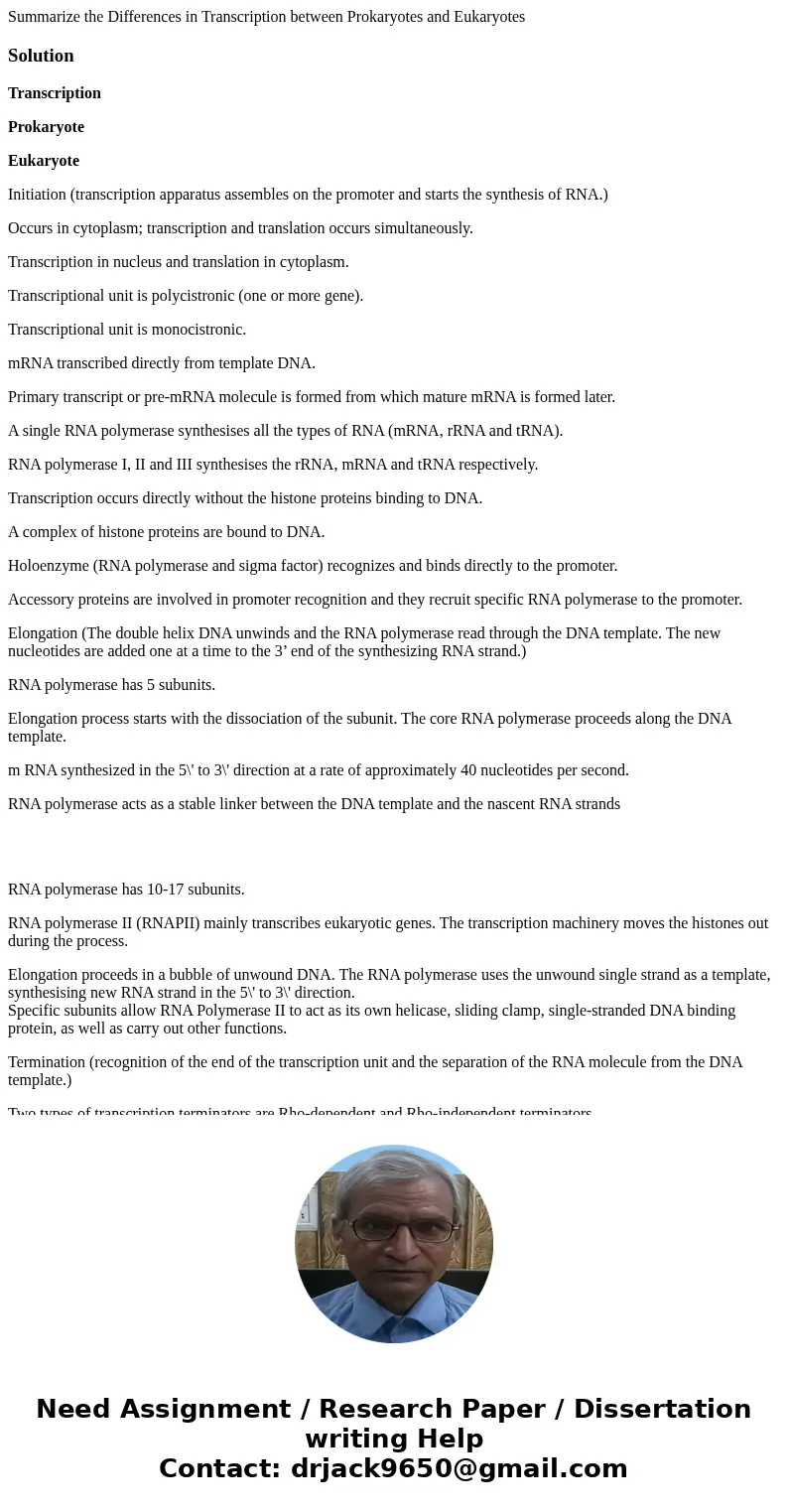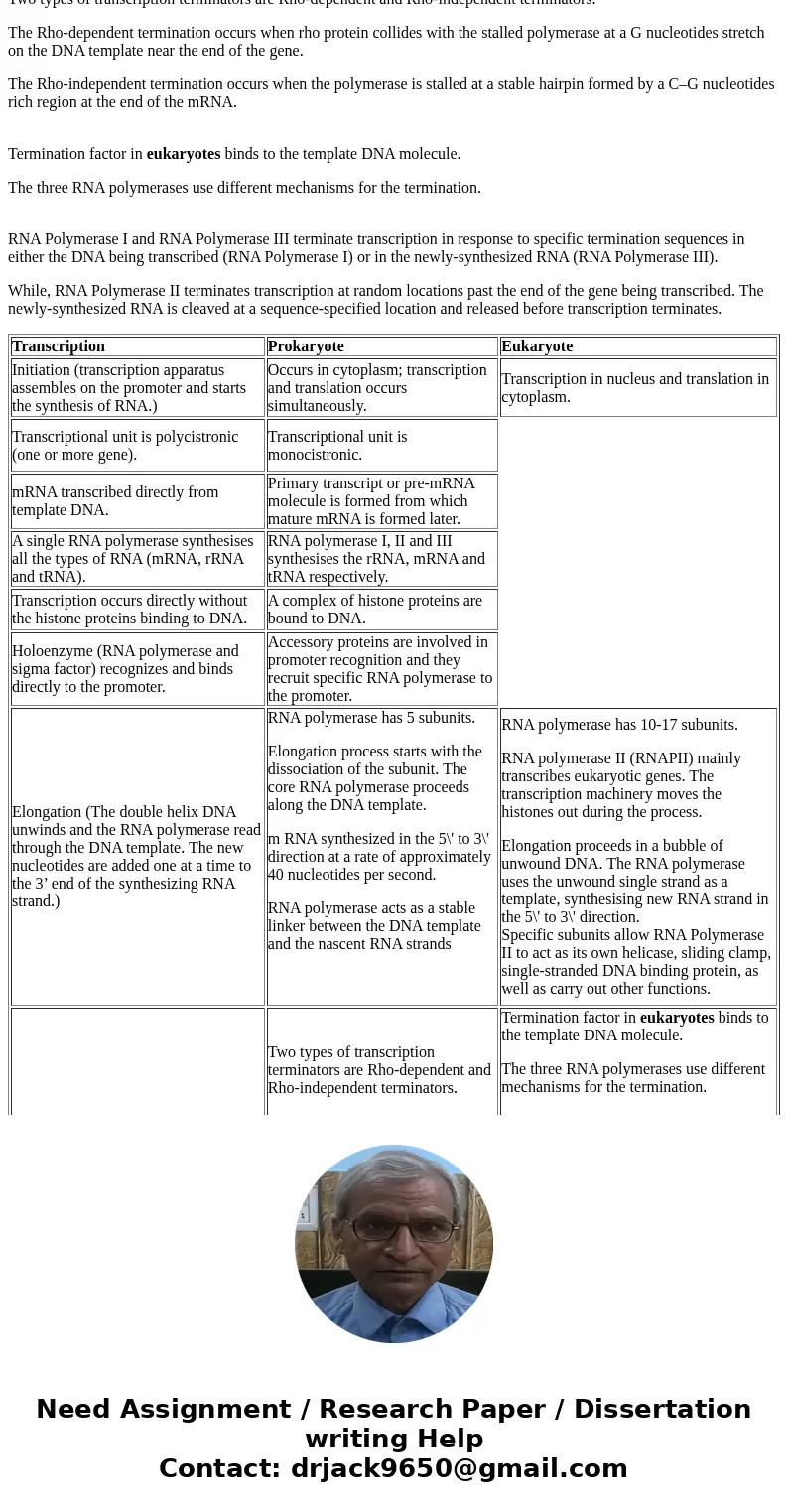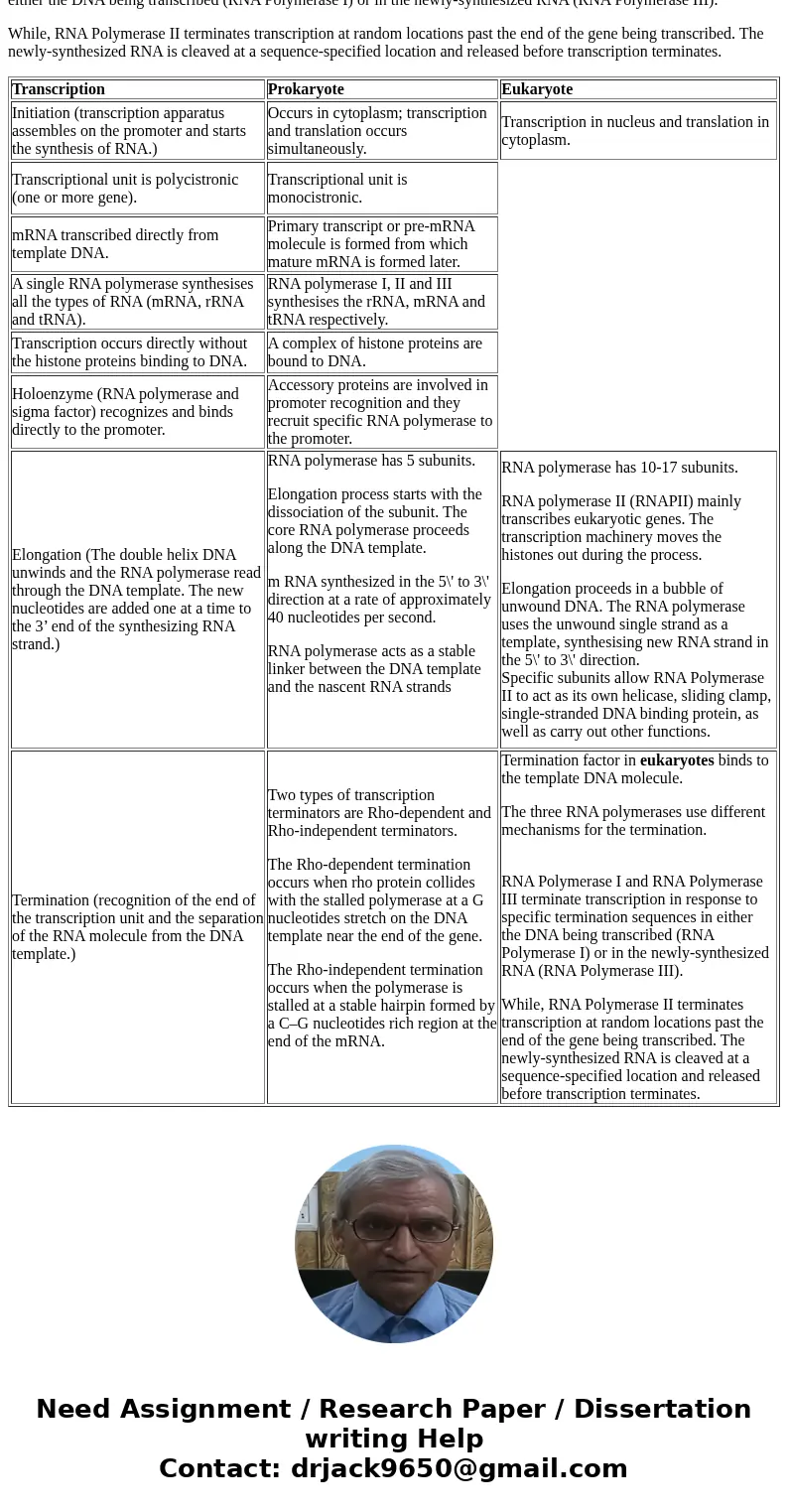Summarize the Differences in Transcription between Prokaryot
Solution
Transcription
Prokaryote
Eukaryote
Initiation (transcription apparatus assembles on the promoter and starts the synthesis of RNA.)
Occurs in cytoplasm; transcription and translation occurs simultaneously.
Transcription in nucleus and translation in cytoplasm.
Transcriptional unit is polycistronic (one or more gene).
Transcriptional unit is monocistronic.
mRNA transcribed directly from template DNA.
Primary transcript or pre-mRNA molecule is formed from which mature mRNA is formed later.
A single RNA polymerase synthesises all the types of RNA (mRNA, rRNA and tRNA).
RNA polymerase I, II and III synthesises the rRNA, mRNA and tRNA respectively.
Transcription occurs directly without the histone proteins binding to DNA.
A complex of histone proteins are bound to DNA.
Holoenzyme (RNA polymerase and sigma factor) recognizes and binds directly to the promoter.
Accessory proteins are involved in promoter recognition and they recruit specific RNA polymerase to the promoter.
Elongation (The double helix DNA unwinds and the RNA polymerase read through the DNA template. The new nucleotides are added one at a time to the 3’ end of the synthesizing RNA strand.)
RNA polymerase has 5 subunits.
Elongation process starts with the dissociation of the subunit. The core RNA polymerase proceeds along the DNA template.
m RNA synthesized in the 5\' to 3\' direction at a rate of approximately 40 nucleotides per second.
RNA polymerase acts as a stable linker between the DNA template and the nascent RNA strands
RNA polymerase has 10-17 subunits.
RNA polymerase II (RNAPII) mainly transcribes eukaryotic genes. The transcription machinery moves the histones out during the process.
Elongation proceeds in a bubble of unwound DNA. The RNA polymerase uses the unwound single strand as a template, synthesising new RNA strand in the 5\' to 3\' direction.
Specific subunits allow RNA Polymerase II to act as its own helicase, sliding clamp, single-stranded DNA binding protein, as well as carry out other functions.
Termination (recognition of the end of the transcription unit and the separation of the RNA molecule from the DNA template.)
Two types of transcription terminators are Rho-dependent and Rho-independent terminators.
The Rho-dependent termination occurs when rho protein collides with the stalled polymerase at a G nucleotides stretch on the DNA template near the end of the gene.
The Rho-independent termination occurs when the polymerase is stalled at a stable hairpin formed by a C–G nucleotides rich region at the end of the mRNA.
Termination factor in eukaryotes binds to the template DNA molecule.
The three RNA polymerases use different mechanisms for the termination.
RNA Polymerase I and RNA Polymerase III terminate transcription in response to specific termination sequences in either the DNA being transcribed (RNA Polymerase I) or in the newly-synthesized RNA (RNA Polymerase III).
While, RNA Polymerase II terminates transcription at random locations past the end of the gene being transcribed. The newly-synthesized RNA is cleaved at a sequence-specified location and released before transcription terminates.
| Transcription | Prokaryote | Eukaryote |
| Initiation (transcription apparatus assembles on the promoter and starts the synthesis of RNA.) | Occurs in cytoplasm; transcription and translation occurs simultaneously. | Transcription in nucleus and translation in cytoplasm. |
| Transcriptional unit is polycistronic (one or more gene). | Transcriptional unit is monocistronic. | |
| mRNA transcribed directly from template DNA. | Primary transcript or pre-mRNA molecule is formed from which mature mRNA is formed later. | |
| A single RNA polymerase synthesises all the types of RNA (mRNA, rRNA and tRNA). | RNA polymerase I, II and III synthesises the rRNA, mRNA and tRNA respectively. | |
| Transcription occurs directly without the histone proteins binding to DNA. | A complex of histone proteins are bound to DNA. | |
| Holoenzyme (RNA polymerase and sigma factor) recognizes and binds directly to the promoter. | Accessory proteins are involved in promoter recognition and they recruit specific RNA polymerase to the promoter. | |
| Elongation (The double helix DNA unwinds and the RNA polymerase read through the DNA template. The new nucleotides are added one at a time to the 3’ end of the synthesizing RNA strand.) | RNA polymerase has 5 subunits. Elongation process starts with the dissociation of the subunit. The core RNA polymerase proceeds along the DNA template. m RNA synthesized in the 5\' to 3\' direction at a rate of approximately 40 nucleotides per second. RNA polymerase acts as a stable linker between the DNA template and the nascent RNA strands | RNA polymerase has 10-17 subunits. RNA polymerase II (RNAPII) mainly transcribes eukaryotic genes. The transcription machinery moves the histones out during the process. Elongation proceeds in a bubble of unwound DNA. The RNA polymerase uses the unwound single strand as a template, synthesising new RNA strand in the 5\' to 3\' direction. |
| Termination (recognition of the end of the transcription unit and the separation of the RNA molecule from the DNA template.) | Two types of transcription terminators are Rho-dependent and Rho-independent terminators. The Rho-dependent termination occurs when rho protein collides with the stalled polymerase at a G nucleotides stretch on the DNA template near the end of the gene. The Rho-independent termination occurs when the polymerase is stalled at a stable hairpin formed by a C–G nucleotides rich region at the end of the mRNA. | Termination factor in eukaryotes binds to the template DNA molecule. The three RNA polymerases use different mechanisms for the termination.
While, RNA Polymerase II terminates transcription at random locations past the end of the gene being transcribed. The newly-synthesized RNA is cleaved at a sequence-specified location and released before transcription terminates. |



 Homework Sourse
Homework Sourse